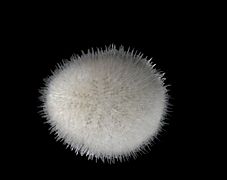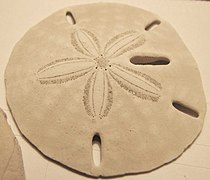Irregularia: Difference between revisions
Appearance
Content deleted Content added
taxobox cleanup |
Barrett.xiii (talk | contribs) |
||
| (10 intermediate revisions by 9 users not shown) | |||
| Line 1: | Line 1: | ||
{{Short description|Group of sea urchins}} |
|||
{{Taxobox |
|||
{{Automatic taxobox |
|||
| name = Irregularia |
| name = Irregularia |
||
| image = Echinocardium_cordatum.jpg |
| image = Echinocardium_cordatum.jpg |
||
| image_caption = ''[[Echinocardium|Echinocardium cordatum]]'' |
| image_caption = ''[[Echinocardium|Echinocardium cordatum]]'' |
||
| fossil_range = {{Fossil range|Lower Jurassic|recent}} |
| fossil_range = {{Fossil range|Lower Jurassic|recent}} |
||
| |
| taxon = Irregularia |
||
| ⚫ | |||
| phylum = [[Echinodermata]] |
|||
| classis = [[Echinoidea]] |
|||
| infraclassis = '''Irregularia''' |
|||
| ⚫ | |||
| subdivision_ranks = Superorders |
| subdivision_ranks = Superorders |
||
| subdivision = |
| subdivision = |
||
| Line 15: | Line 13: | ||
}} |
}} |
||
'''Irregularia''' is an [[extant taxon|extant]] infraclass of [[sea urchin]]s that first appeared in the Lower [[Jurassic]]. |
'''Irregularia''' is an [[extant taxon|extant]] infraclass of [[sea urchin]]s that first appeared in the Lower [[Jurassic]]. |
||
== Description and characteristics == |
== Description and characteristics == |
||
These particular sea urchins are distinguished from other sea urchins by their irregular shape |
These particular sea urchins are distinguished from other sea urchins by their irregular shape: the anus and often even the mouth are at the two poles of the test, creating a bilateral symmetry instead of the classical 5-fold symmetry of [[echinoderm]]s. The group includes the well known [[Spatangoida|heart urchin]]s, as well as flattened [[sand dollar]]s, [[Clypeasteroida|sea biscuits]] and some other forms. Most of them live inside the sediment, moving in thanks to their particular spines, and feed on its organic fraction. |
||
<gallery style="text-align:center;" mode="packed"> |
<gallery style="text-align:center;" mode="packed"> |
||
Image:Heart urchin Spatangoida 1380049 Nevit.jpg| |
Image:Heart urchin Spatangoida 1380049 Nevit.jpg|{{center|Test of a [[spatangoida|spatangoid]] (oral face): the mouth is on the right and the anus on the left.}} |
||
Image:Echinocyamus pusillus.jpg| |
Image:Echinocyamus pusillus.jpg|{{center|''[[Echinocyamus pusillus]]''. }} |
||
Image:Keyhole sand dollar 01.jpg| |
Image:Keyhole sand dollar 01.jpg|{{center|Test of a ''[[Mellita quinquiesperforata]]''. }} |
||
Image:Live Sand Dollar trying to bury itself in beach sand.jpg| |
Image:Live Sand Dollar trying to bury itself in beach sand.jpg|{{center|A "[[sand dollar]]" in its environment.}} |
||
</gallery> |
</gallery> |
||
<gallery style="text-align:center;" mode="packed"> |
<gallery style="text-align:center;" mode="packed"> |
||
Image:Clypeaster reticulatus both sides.jpg| |
Image:Clypeaster reticulatus both sides.jpg|{{center|''[[Clypeaster reticulatus]]'' (family ''[[Clypeasteridae]]'').}} |
||
Image:Encope emarginata (Leske, 1778) derivate 2013.jpg| |
Image:Encope emarginata (Leske, 1778) derivate 2013.jpg|{{center|''[[Encope emarginata]]'' (aboral and oral faces) drawn by [[Ernst Haeckel]] (1904). }} |
||
Image :Clypeaster rosaceus (Linnaeus, 1758) derivate 2013.jpg| |
Image :Clypeaster rosaceus (Linnaeus, 1758) derivate 2013.jpg|{{center|''[[Clypeaster rosaceus]]'', ''ibid''. }} |
||
Image:Clypeaster aegypticus (inside).JPG| |
Image:Clypeaster aegypticus (inside).JPG|{{center|Many slices of a ''[[Clypeaster aegypticus]]'', showing buttresses and pillars.}} |
||
</gallery> |
</gallery> |
||
| Line 36: | Line 34: | ||
[[Image:MHNT_-_Hemipneustes_pyrenaicus_-_1.jpg|thumb|upright=0.8|Fossil of an ''[[Hemipneustes pyrenaicus]]'' ([[Holasteroida]]).]] |
[[Image:MHNT_-_Hemipneustes_pyrenaicus_-_1.jpg|thumb|upright=0.8|Fossil of an ''[[Hemipneustes pyrenaicus]]'' ([[Holasteroida]]).]] |
||
[[Image:Ruhrmuseum-Ebene-12-Naturkunde3784.jpg|thumb|upright=0.8|Fossil of a ''[[Conulus subroundatus]]'' ([[Echinoneoida]]).]] |
[[Image:Ruhrmuseum-Ebene-12-Naturkunde3784.jpg|thumb|upright=0.8|Fossil of a ''[[Conulus subroundatus]]'' ([[Echinoneoida]]).]] |
||
[[Image:Scutella subrotunda (Leske, 1778).JPG|thumb|upright=0.8| |
[[Image:Scutella subrotunda (Leske, 1778).JPG|thumb|upright=0.8|{{center|Fossil of a ''[[Scutella subrotunda]]'' ([[Clypeasteroida]]). }}]] |
||
[[Image:Echinolampas ovalis M Eocene Civrac-en-Médoc France.JPG|thumb|upright=0.8|''Echinolampas ovalis'', Middle [[Eocene]], [[Civrac-en-Médoc]], France.]] |
[[Image:Echinolampas ovalis M Eocene Civrac-en-Médoc France.JPG|thumb|upright=0.8|''Echinolampas ovalis'', Middle [[Eocene]], [[Civrac-en-Médoc]], France.]] |
||
[[Image:Echinolampas ovalis M Eocene Civrac-en-Médoc France oral.JPG|upright=0.8|thumb|''Echinolampas ovalis'', Middle Eocene, Civrac-en-Médoc, France; oral surface.]] |
[[Image:Echinolampas ovalis M Eocene Civrac-en-Médoc France oral.JPG|upright=0.8|thumb|''Echinolampas ovalis'', Middle Eocene, Civrac-en-Médoc, France; oral surface.]] |
||
| Line 65: | Line 63: | ||
** fossil family [[Pygaulidae]] <small> Lambert, 1905</small> † |
** fossil family [[Pygaulidae]] <small> Lambert, 1905</small> † |
||
** fossil genus ''[[Pygolampas]]''<small> Saucède, Dudicourt & Courville, 2012</small> † |
** fossil genus ''[[Pygolampas]]''<small> Saucède, Dudicourt & Courville, 2012</small> † |
||
* fossil order [[Oligopygoida]] <small> Kier, 1967</small> † |
|||
* fossil family [[Pygasteridae]] <small> Lambert, 1900</small> † |
* fossil family [[Pygasteridae]] <small> Lambert, 1900</small> † |
||
* fossil family [[Pygorhytidae]] <small> Lambert, 1909b</small> † |
* fossil family [[Pygorhytidae]] <small> Lambert, 1909b</small> † |
||
| Line 71: | Line 70: | ||
* {{cite book |author= Barnes, Robert D. |year=1982 |title= Invertebrate Zoology |publisher= Holt-Saunders International |location= Philadelphia, PA|page= 981|isbn= 0-03-056747-5}} |
* {{cite book |author= Barnes, Robert D. |year=1982 |title= Invertebrate Zoology |publisher= Holt-Saunders International |location= Philadelphia, PA|page= 981|isbn= 0-03-056747-5}} |
||
* {{cite worms | id = 510499 | db = Echinoidea | title = Irregularia}} |
* {{cite worms | id = 510499 | db = Echinoidea | title = Irregularia}} |
||
{{Taxonbar|from=Q15735627}} |
|||
[[Category:Echinoidea]] |
[[Category:Echinoidea]] |
||
{{taxonbar}} |
|||
{{echinoidea-stub}} |
{{echinoidea-stub}} |
||
Latest revision as of 23:43, 6 February 2024
| Irregularia Temporal range:
| |
|---|---|

| |
| Echinocardium cordatum | |
| Scientific classification | |
| Domain: | Eukaryota |
| Kingdom: | Animalia |
| Phylum: | Echinodermata |
| Class: | Echinoidea |
| Subclass: | Euechinoidea |
| Infraclass: | Irregularia Latreille, 1825 |
| Superorders | |
Irregularia is an extant infraclass of sea urchins that first appeared in the Lower Jurassic.
Description and characteristics
[edit]These particular sea urchins are distinguished from other sea urchins by their irregular shape: the anus and often even the mouth are at the two poles of the test, creating a bilateral symmetry instead of the classical 5-fold symmetry of echinoderms. The group includes the well known heart urchins, as well as flattened sand dollars, sea biscuits and some other forms. Most of them live inside the sediment, moving in thanks to their particular spines, and feed on its organic fraction.
-
Test of a spatangoid (oral face): the mouth is on the right and the anus on the left.
-
Test of a Mellita quinquiesperforata.
-
A "sand dollar" in its environment.
-
Clypeaster reticulatus (family Clypeasteridae).
-
Encope emarginata (aboral and oral faces) drawn by Ernst Haeckel (1904).
-
Clypeaster rosaceus, ibid.
-
Many slices of a Clypeaster aegypticus, showing buttresses and pillars.
Taxonomy
[edit]


Fossil of a Scutella subrotunda (Clypeasteroida).


- super-order Atelostomata
- fossil family Acrolusiidae Mintz, 1968 †
- fossil family Collyritidae d'Orbigny, 1853 †
- fossil family Disasteridae Gras, 1848 †
- order Holasteroida
- order Spatangoida
- fossil family Tithoniidae Mintz, 1968 †
- fossil genus Atlasaster Lambert, 1931 †
- fossil family Desorellidae Lambert, 1911a †
- order Echinoneoida
- fossil family Galeropygidae Lambert, 1911a †
- fossil genus Grasia Michelin, 1854 †
- fossil order Holectypoida †
- fossil family Menopygidae Lambert, 1911 †
- fossil genus Mesodiadema Neumayr, 1889 †
- super-order Neognathostomata
- familia Apatopygidae Kier, 1962
- fossil family Archiaciidae Cotteau & Triger, 1869 †
- order Cassiduloida
- order Clypeasteroida
- fossil family Clypeidae Lambert, 1898 †
- fossil family Clypeolampadidae Kier, 1962 †
- order Echinolampadoida
- fossil family Nucleolitidae L. Agassiz & Desor, 1847 †
- fossil family Pygaulidae Lambert, 1905 †
- fossil genus Pygolampas Saucède, Dudicourt & Courville, 2012 †
- fossil order Oligopygoida Kier, 1967 †
- fossil family Pygasteridae Lambert, 1900 †
- fossil family Pygorhytidae Lambert, 1909b †
References
[edit]- Barnes, Robert D. (1982). Invertebrate Zoology. Philadelphia, PA: Holt-Saunders International. p. 981. ISBN 0-03-056747-5.
- Kroh A, Mooi R (eds.). "Irregularia". World Echinoidea Database. World Register of Marine Species.









